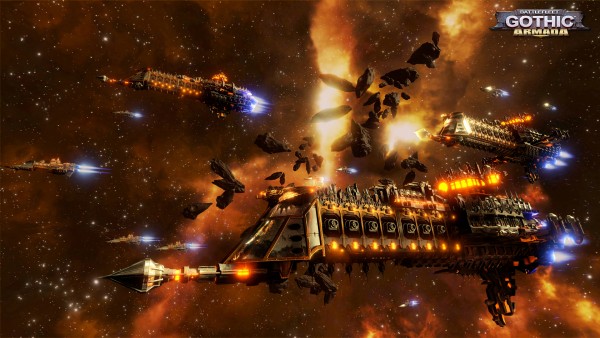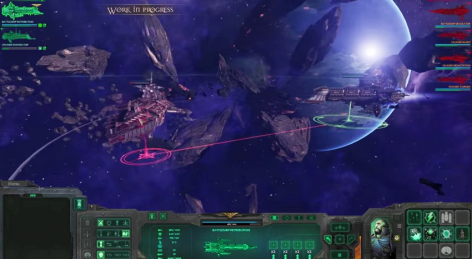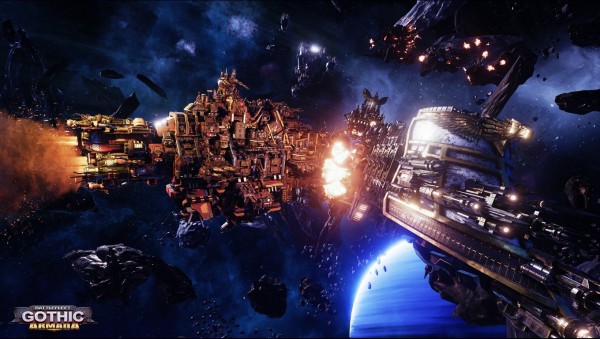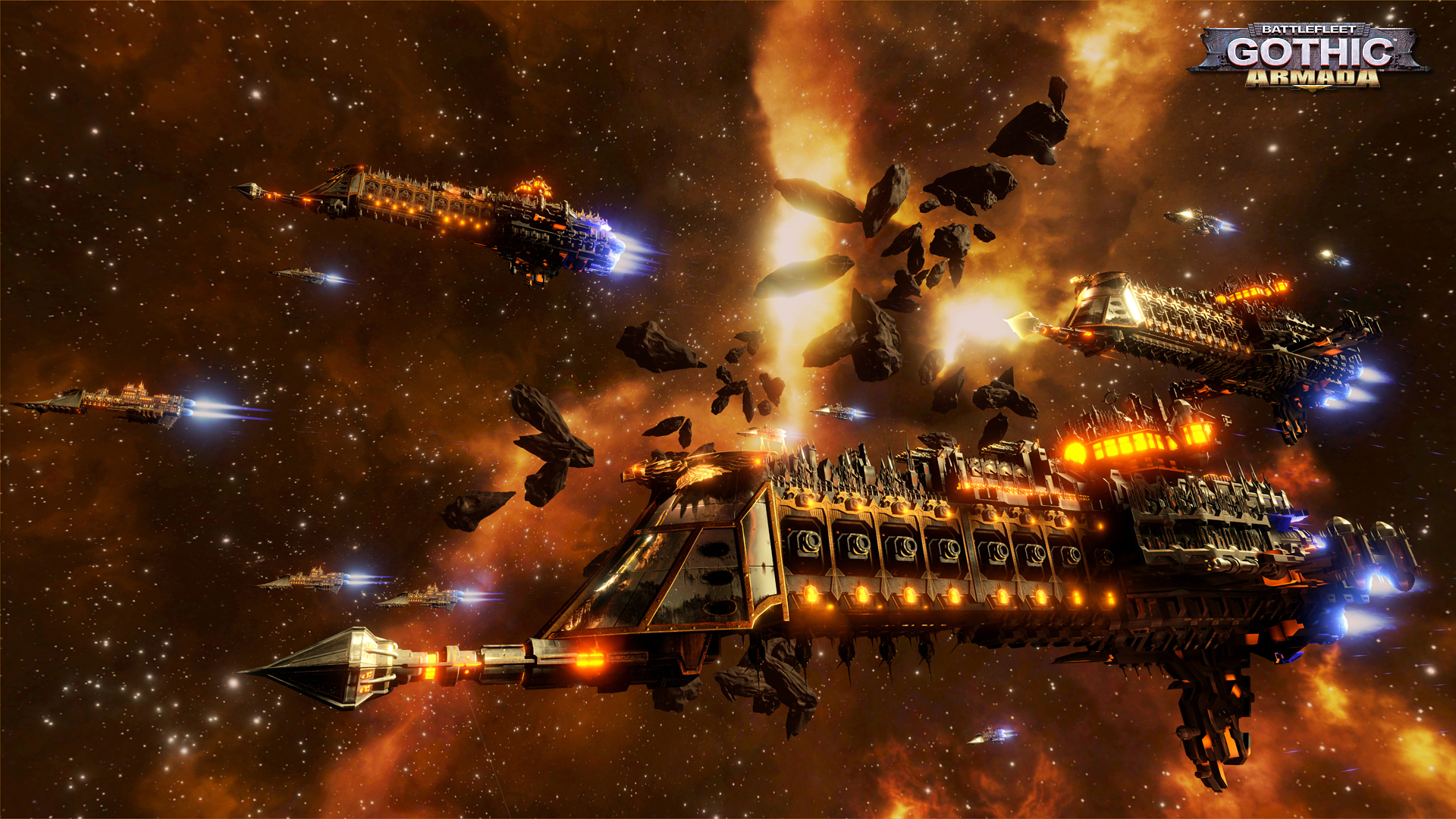If you have read any of my content at all on this site you know I absolutely love anything in the Warhammer 40,000 Universe. So when I heard that Tindalos Interactive was bringing their expertise in space combat to the Warhammer universe I was extremely excited. The result of all of their hard work is Battlefleet Gothic Armada. Fans of the Warhammer table top games will know that Battlefleet Gothic is the space branch of the 40K universe of games, and involves a much different rule set than the tabletop game. Ships still have gear, and crew, and all sorts of manuvers, but Gothic is a slower more strategic game. Knowing that I went in expecting a fairly faithful recreation of the game, and Tindalos has done a really good job of that. The game is real time, but other than that change, it feels extremely similar to the tabletop.

To understand the story mode you may want to dig in to 40K lore a little bit, but basically the Gothic Sector is its own area of space, quite close to the eye of terror. From the eye of Terror, which is a rent in space emerges Abadon the despoiler and he’s here to kill humans, in the name of Chaos. So stars the Gothic War. That’s about the entire story I needed. It should be mentioned here that the Beta we were given access to, only gave us access to the first act of the story. This arc, which is a tutorial of sorts and showed off only three of the 4 races, but already, I am in love with this game and its story.
The real question of course is how does that story and gameplay translate to the PC experience? So far very well. The game is fun, its deep but not impossible to get in to, it has plenty of room for charging in and trying to just brute force things, but also requires strategy and longer term planning and larger thinking to overrule brute force. A very nice tutorial is provided for players who may not understand how RTS style games work. This is really important because moving a ship is nothing like moving units in standard RTS. The huge ships of the world of Warhammer do not turn on a dime, instead they shift, have weight, and move like you might expect a spaceship to move.
Movement is extremely micro heavy, with each ship being able to use thrusters to make hard burns, which cause them to turn quickly, or move faster, at the cost of being revealed to the enemy. The more ships you bring, the more likely you are to win, but it comes with the tradeoff of not being able to micromanage the ships as well.
In the single player mode where I spent most of my time, players are first asked to create an admiral. This will be your avatar, and will follow you through your campaign. Each admiral you create will have a different set of ships, so you can basically keep separate save files by having different admirals. I selected the venerable armies of the Imperium of man to play as. Of the two selectable races in the Beta, they are the more durable, and since I tend to play most games in an upfront rush in style, they seemed more to my taste
Each ship has abilities and a basic attack, for the human faction their powerful broadside cannons are the staple of their attack power. They also have fighters, bombs, and a slew of other weapons including their “ultimate weapon” the NOVA cannon. Personally I prefer to use torpedos, slow moving dumb projectiles that go in a straight line and do massive damage if you can hit with them.
There is a lot of room to build different weapons and ship systems. There are upgrades galore in store for the campaign and since you build your fleets I presume the same will happen in multiplayer. There are so many customizations and builds that I could honestly write a whole separate review on just those bits and bobs, but sufficient to say that you will be spending some time choosing what you want for each of your ships.

Ships are selected in the initial screen, and just like in the table top game, each ship has a point value. Each ship has the ability to upgrade crew, equipment, weapons, and shields. These upgrades are cumulative, and you get to use them throughout the campaign you set up. The logner you play the same ships, the more experience those ships get, and the more powerful they end up being. This can create a sort of roguelike experience because ships and crews can be lost, and replacements must be obtained in order to re-deploy the ship.
All of that stuff occurs before the game even starts, after selecting ships under the necessary point value. You then get to deploy then in the deployment zone which is usually the ends of the large square map. Deployment so far for me has basically been all three ships getting as close together as possible, but I imagine some minds more strategic than my own might be able to set up a better system.
After deploying ships the game finally starts. The first order of business for me was usually to search the map for any nebulas, which provide cloaking to a ship and head for those. Each map features some terrain, in the form of minefield, asteroids, and clouds of dust and gas. These can figure in to the game, but don’t play as large of a role as I had hoped they would. The only one that really matters is the asteroids and that is because they can do damage to your ships should you be not paying attention and run in to them. This is fairly easy to do when you are managing the trajectory, weapons, shields, special attacks, and damage repair of multiple ships.
Micromanagement is key in this game, each ship has several focuses, the ability to for example, brace for impact, or focus fire, all of which have to be triggered manually. Boarding parties (which come in two varieties) also have to be manually triggered, as to wings of fighters, bombers, and even torpedos. The easiest analogy I can make, is that each ship is a character in a MOBA style game. They have an auto attack, and the rest of their abilities are triggered requiring your oversight to use. What makes this game really brilliant Is that you have to do that with 3, 4, sometimes as many as 6 ships at once. This requires a supreme level of management that I found to be both frustrating and rewarding. Nothing quite like not even noticing one of your ships is gone until minutes after you lost it because you were concentrating on getting that one ship positioned perfectly for a full broadside!
Ship damage is compartmentalized. Each and every ship system can be focused and damaged separately. Meaning if I have a ship that’s taken damage to its side guns, I can still use it to launch torpedoes, or if I have a ship that’s taken damage to its hangers, it can still shoot. A ship is never truly useless, since even when without weapons it can simply ram another ship. The tradeoff of course is that a ship can always be repaired, but once its destroyed its destroyed it must be re-crewed and will lose some bonuses. To prevent that from happening all ships can at all time “warp out” of the battle space, freeing them from the confines of war, and sending them back to home base. Of course they cannot return during that battle, so this is in effect a retreat, and doing so too early can swing your battles heavily.

Overall I am enjoying the combat aspects most out of the games many facets. While it builds a great story, I think I will wait for the full release to comment much on it, since in its current state its incomplete. The combat feels fluid, even if it is slow, and the different mission types make the game more than just a constant go out and kill everything in space sim. While I feel combat could get repetitive quickly, that is something all space games risk, after all the basics of space combat don’t change much over time. I am sure that onece I get in to the story, ill find myself sucked in to the Warhammer lore, and end up spending hours and hours reading bits about chaos gods, and Orc warchiefs, and for now I can just keep pummeling the forces of chaos in cruiser battles.
Check out this Twitch VOD if you are intrested in what the looks like in action.
<iframe src=”https://player.twitch.tv/?video=v54493237″ frameborder=”0″ scrolling=”no” height=”378″ width=”620″>Watch live video from SGIG on www.twitch.tv
